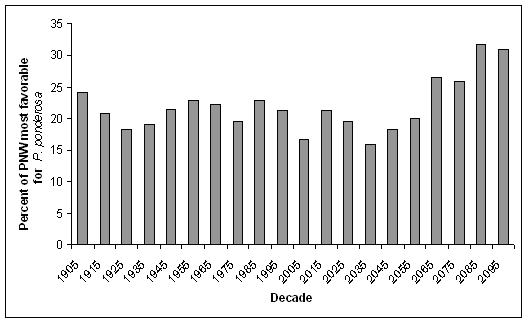- To assess the influence of climate variability on the annual productivity of ponderosa pine ecosystems in the Pacific Northwest over the past 100 years
- To explain how climate variability limits the current distribution of ponderosa pine in the region.
Influence of Climate Variability on the Productivity and Distribution of Ponderosa Pine Ecosystems in the Pacific Northwest: Combination of a Process-Based Model and a 102-Year High Resolution Climate Data Set.
We used a spatial modelling technique to assess the influence of climatic variability on the annual productivity of P. ponderosa in the Pacific Northwest (PNW) of North America, over the past 100 years and infer how a sustained change in climate might alter the geographic distribution of this species across defined ecotones. Field observations were used to establish three criteria to define where P. ponderosa should maintain sustained dominance:
- maximum summer leaf area index, (LAI), should fall between 1.5 and 2.5
- up to 80% of available soil water will be depleted during the summer
- soil water storage will reach capacity sometime during the year
Where these three criteria were not met, we predicted that P. ponderosa would be eventually replaced. We used a simple physiological model, 3-PG. to predict annual variation in LAI from climatic data provided by the Oregon Climate Service over the period from 1900 -2000 and from broad scale 0.5° spatial resolution future climate projections produced by the Hadley Climate Center, UK. From these simulations we produced a series of maps that display predicted shifts of zones where ponderosa pine might be expected to contract or expand its range if modeled climatic conditions at annual and decadal intervals were sustained.
Highlights
- Historical simulations indicated that the most favorable decade was in the 1900’s and the least favorable in the 1930’s
- Future predictions suggested a reduction in the current range of ponderosa pine along the western Cascade Mountains, but an increase along the east side of the Cascades and inland towards the eastern Oregon/Washington border
- Model predictions are that pine dominance should increase between 5 and 10% over the next century, mainly in inland Oregon, Idaho and Washington.

Percentage of the PNW deemed suitable for P. ponderosa based on diagnostic criteria and simulations with 3-PG on the historical and future climatic sequence, summarized by decade

Cumulative predictions of P. ponderosa distribution in eastern PNW over the last and current century. Black indicates where P. ponderosa would be expected to sustain dominance; white indicates where other species should be more competitive.